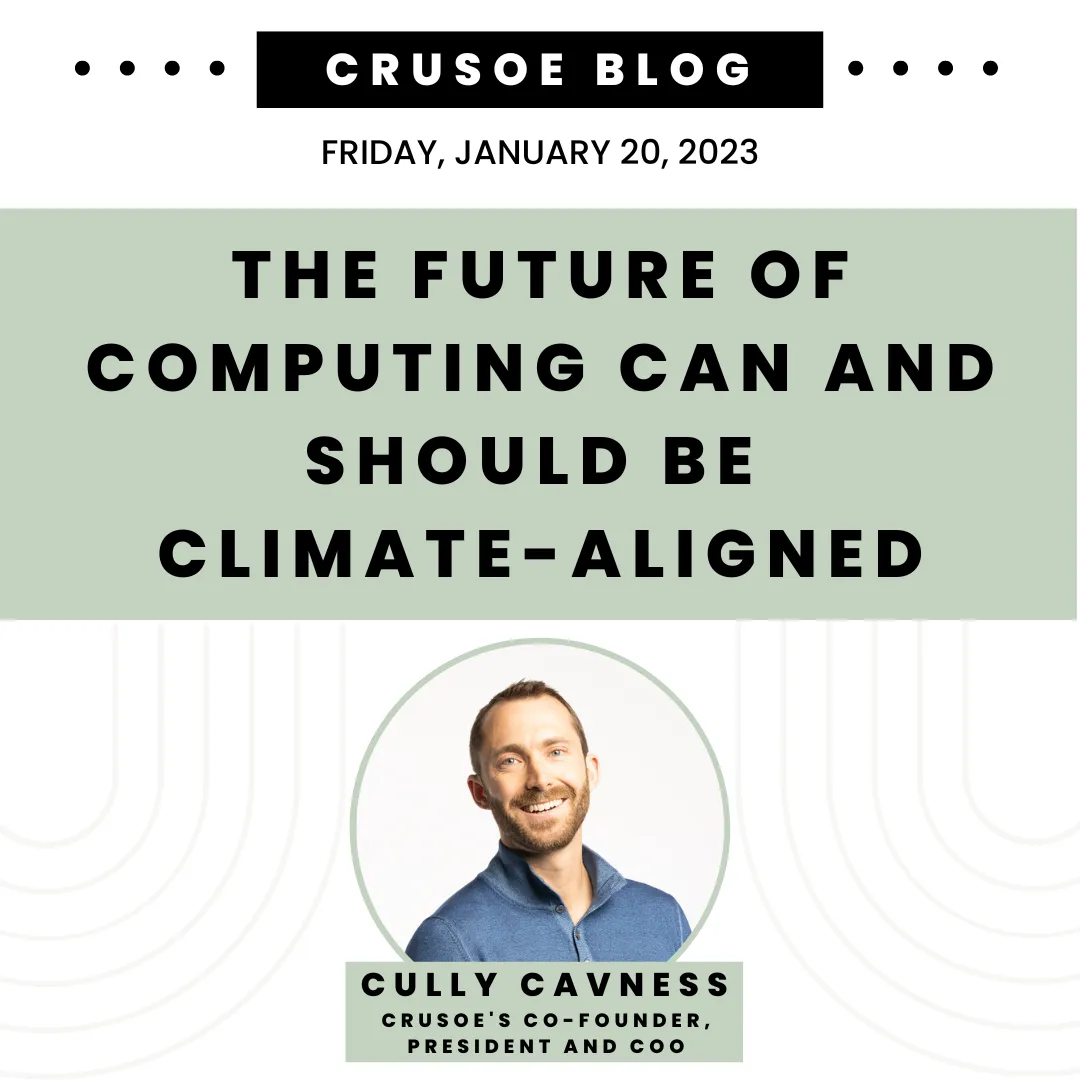The future of computing can and should be climate-aligned
In our January blog post, “The Future Of Computing Can And Should Be Climate-Aligned”, Crusoe’s Co-Founder and President Cully Cavness reflects on joining experts from around the world at CES. He was blown away by the incredible technological innovations on display and the experience offered a glimpse into what our future could look like — particularly the advances being made in the development of machine learning and artificial intelligence --- however it is clear that future is going to be incredibly energy intensive.

A couple weeks ago, I had the opportunity to attend and speak at CES — one of the most influential tech events in the world and the proving ground for breakthrough technologies and global innovators. While wandering the exhibition floor, taking in a number of exciting presentations, and speaking with fellow attendees, I was blown away by the incredible technological innovations on display. The experience offered a glimpse into what our future could look like — particularly the advances being made in the development of machine learning and artificial intelligence.
I was struck by one prevailing thought– this future reality will require an unbelievable amount of energy.
Innovation Continues to Drive Forward
There’s no better place than CES to witness firsthand how society continues to innovate and push the bounds of technology. Take for example the field of Artificial Intelligence (AI):
- Companies like Smart Eye that use human emotion recognition technology to scan eye and facial movements and can detect when a driver becomes distracted or drowsy.
- The application of AI in chatbots like ChatGPT and other large language models (LLMs) as a co-pilot for coding, which will soon enable the non-technical to produce increasingly sophisticated software and may redefine the future of tech entrepreneurship and business.
- John May, CEO of John Deere, gave a keynote that addressed the use of AI to help farmers manage their crops at scale, introducing new technology that reduces waste by using sensors and robotics to more precisely seed, weed, and fertilize crops.
- A senior official from the Department of Homeland Security touted law enforcement and security applications of AI.
These specific use cases represent just a few examples of the broad scope of AI’s potential, and that’s without even mentioning arts, gaming, entertainment, and more. And the same variety of applications were on display for everything from machine learning to blockchain technology to the future of Smart Cities.
Innovation Requires Energy
Perhaps the one factor tempering optimism about technology’s potential is the massive amount of energy required to power these innovations. Throughout the conference, I heard repeated references to just how much energy is required to train these models on large numbers of GPUs. And that energy demand — and associated environmental impact — is poised to inflect sharply upwards as AI and machine learning are increasingly commercialized and operationalized throughout the economy.
The reality is that as our world becomes more digitized, connected, and advanced, these innovations ultimately require energy. This theme was so prevalent at CES that Energy Secretary Jennifer Granholm was on hand to speak about “Powering the Clean Energy Future” — calling for increased use of clean energies including hydrogen, geothermal, and even fusion energy.
At Crusoe we are capturing stranded energy assets and channeling them towards beneficial and carbon-intensive computing. In fact, I was in attendance to speak at a panel entitled “E-merging Energy” — addressing how new digital technologies can be used to enable and incentivize a cleaner energy future.
The Need for Climate-Aligned Data Centers
Increased demand for digital services means that data centers and data transmission networks each account for about 1-1.5% of global electricity use today. Projections by the IEA put data centers on track to consume 8% of global electricity by 2030 — a huge ramp during this decade. With the expanded application of blockchain, machine learning, AI, and other emerging services and technologies, demand for data centers and data transmission networks will continue to grow rapidly for the foreseeable future.
The international community has set ambitious targets to limit global warming and reduce greenhouse gas (GHG) emissions. Accordingly, many of the companies pushing the boundaries of innovation are doing so while mindful of their own commitments to sustainability.
Balancing the exponential need for computing power with the urgency to reduce emissions has led to increased demand for green data centers. In the years ahead, the global green data center market projects nearly 20% annual growth — expected to grow from $48.63 billion in 2021 to $120.26 billion by 2026.
Solving the Next Big Environmental Challenge for Computing Infrastructure: Introducing Crusoe Cloud
Those of you following Crusoe for the past five years have seen how we have transformed the Bitcoin mining industry by turning the energy appetite of Proof-of-Work (PoW) blockchains into a modular and mobile flare-catcher — preventing more than 4 billion cubic feet of flaring and hundreds of thousands of cars worth of GHG emissions since we launched in 2018. In the coming months, Crusoe Energy will launch Crusoe Cloud — a cloud computing platform for AI, machine learning, and High Performance Computing (HPC). Rooted in Crusoe’s unique infrastructure that captures wasted, curtailed or stranded energy, Crusoe Cloud will provide scalable, clean, low-cost cloud solutions for compute-intensive applications. Crusoe Cloud represents the next step forward on our mission to solve the environmental challenges of computing infrastructure for the technology industry.



